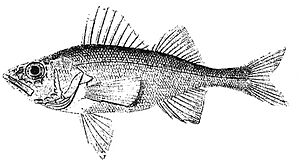Azov percarina facts for kids
Quick facts for kids Azov percarina |
|
|---|---|
 |
|
| Conservation status | |
| Scientific classification | |
| Synonyms | |
|
The Azov percarina (Percarina maeotica) is a small, interesting fish. It belongs to the Percidae family, which includes fish like perch and walleye. This fish is a type of ray-finned fish, meaning its fins are supported by bony rays. The Azov percarina is special because it lives in the Sea of Azov and nearby rivers.
What Does It Look Like?
The Azov percarina looks a lot like its close cousin, the common percarina. But there are a few ways to tell them apart! The Azov percarina has scales on its cheeks. Its back is usually dark, and its sides are grey with many small dark dots. Sometimes, these dots can even join together to form bigger spots, especially near its top fins.
Where Does It Live?
You can find the Azov percarina mainly in the eastern and northeastern parts of the Sea of Azov. It also lives in specific bays like the Gulf of Taganrog and Temryuk Bay. You might also spot it in the Bolshoi Akhtanizovski Liman and the Kuban River delta. It's less common in the Don River delta.
How It Lives and What It Eats
The Azov percarina lives in fresh or slightly salty water near the coast. It can handle water with a little salt, up to about 7 parts per thousand. You'll often find them near river mouths.
These fish are social, meaning they like to live in groups called shoals. When they are very small, about 6 millimeters long, they mostly eat tiny water creatures called zooplankton, especially small crustaceans.
As they grow bigger, from about 16 to 40 millimeters, they switch to eating larger crustaceans like copepods and mysids. Once they are about a year old, they become mostly piscivorous, which means they eat other fish. Their favorite meals include Knipowitschia longecaudata and Clupeonella cultriventis. They also enjoy eating worms, molluscs, and insect larvae found on the bottom.
Azov percarina fish become ready to have babies when they are about one year old. They lay their eggs in June and July in the least salty part of the Gulf of Taganrog. After laying eggs, the adult fish swim out to the open sea. The eggs are laid on muddy bottoms and hatch in just two days! The baby fish, called larvae, stay on the bottom for about four days before swimming up to the surface.
About Its Name
The Azov percarina was first officially described in 1888 by a scientist named I.D. Kuznetsov. He found it in the northeastern part of the Sea of Azov.
Sometimes, people thought the Azov percarina was just a type of subspecies of the common percarina. However, scientists have looked closely at their bodies and where they live. These differences show that the Azov percarina is its own unique species. The common percarina is found in places like Ukraine, Moldova, and Romania.


